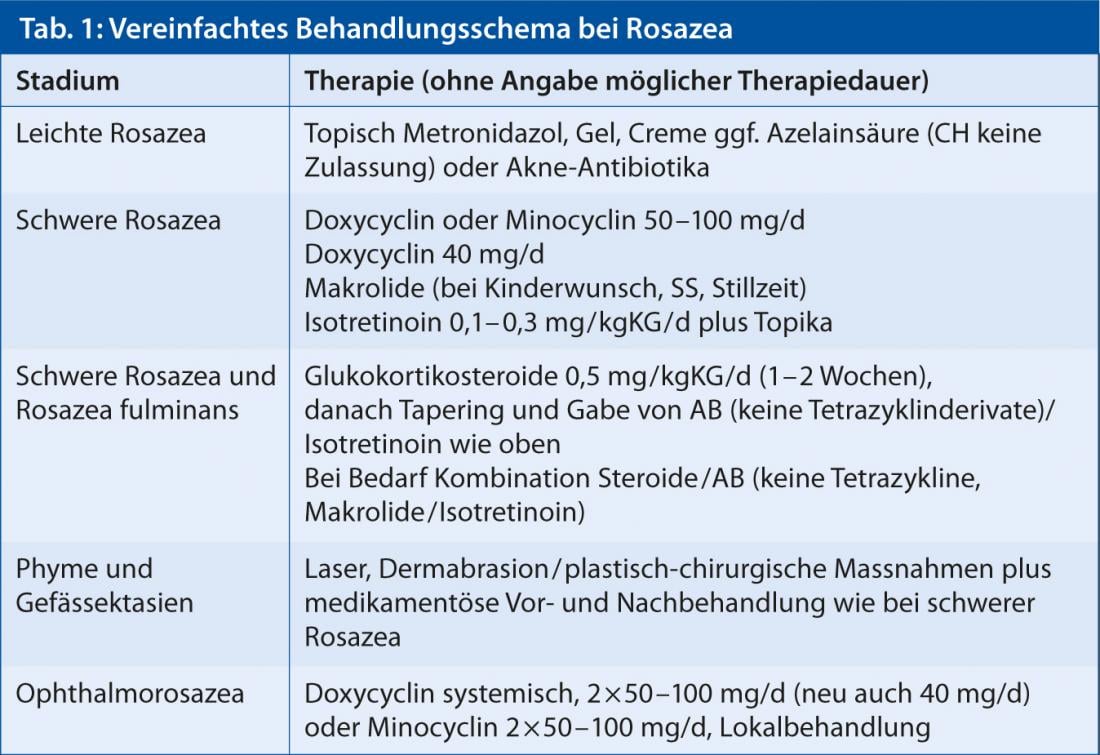Although globally accepted international consensus guidelines are lacking for the treatment of rosacea, the numerous therapeutic options are very much based on evidence-based criteria, as PD Dr. med. Peter Häusermann explained in Zurich. In the complex pathogenesis, individual building blocks are known and used therapeutically. However, exactly where and why inflammatory upregulation begins requires further research.
We do not know of any specific histologically or serologically diagnostic biomarkers for rosacea to date. The broad spectrum of clinical manifestations also makes it difficult to reach an international consensus on therapy, as PD Dr. med. Peter Häusermann, senior physician at the University Hospital Basel, explained at the training event Regional Dermatology of the USZ. It is also important to remember that not only the centrofacial region can be affected, but also the scalp, eyes, ears or décolleté [1].
The prevalence of rosacea ranges from 5% in southern Europe to up to 10% in northern Europe. The disease usually begins between the ages of 30 and 50, but children can also be affected. More men fall ill in old age. The level of suffering is rated as low by about 70% of those affected, whereas one third of patients feel that their quality of life is considerably impaired. A recent study from the UK found an incidence of 165 cases per 100,000 population/year – with 4000-5000 new cases diagnosed annually [2].
Rosacea-specific peptide image
Rosacea is thought to have a hereditary disposition. Disturbances in the innate immune system, neuroinflammatory mechanisms, ultraviolet radiation, local inflammatory responses to cutaneous microorganisms, and alterations in vascular and possibly lymphatic regulation are being considered and investigated as causes.
An important finding concerns the production and activation of cathelicidin peptides, a family of antimicrobial peptides of the skin. In rosacea, a typical pattern of pro-inflammatory cytokines has been found (kallikrein 5, toll-like receptor 2, interleukins 1-6, and tumor necrosis factor-alpha), which also directly affects angiogenesis and blood vessel regulation. Since rosacea worsens after UV exposure, VEGF overexpression and increased reactive oxygen species activities are considered additional causes.
Demodex mites and Bacillus oleronius are considered possible co-factors in the inflammatory response, although rosacea is not an infectious disease, Dr. Häusermann emphasized.
From the factors of pathogenesis known so far, the modes of action of the drugs can also be assigned:
- Metronidazole has an effect on kallikrein 5, making it anti-inflammatory or immunosuppressive; it is also postulated to have activity against reactive oxygen species.
- Azelaic acid is focused on a broad anti-inflammatory effect and normalization of keratinization.
- Antibiotic therapy with tetracyclines also has an anti-inflammatory effect and is very effective against papules and pustules, but has little effect on erythema and telangiectasia.
- The use of isotretinoin results in a noticeable reduction of papules, pustules, erythema, and telangiectasia [3].
Perioral dermatitis POD
Erysipelas, rosacea-like dermatitis, dermatitis perioralis, or stewardess disease is a comparatively “young” disorder, having been described as a distinct entity only in 1964. Perioral dermatitis is a characteristic intolerance reaction of the facial skin, which is based on chronic or repetitive irritation. Among other things, cosmetics and other hydrating substances are suspected to be the cause. Some specialists therapeutically accept zero therapy. The DDG guideline also provides this option for mild forms. Topicals, topical and systemic antibiotics, and isotretinoin are listed for severe form. Pimecrolimus 1% results in accelerated healing of POD and can be used for this indication, but long-term data are lacking.
Lupoid perioral dermatitis is a special form usually triggered by corticosteroids in Afro-Caribbean children (FACE).
Rosacea subtypes
Whereas rosacea was previously divided into stages, since 2002 it has also been referred to as subtypes.
Pre-Rosazea, Functional Erythema: Symptoms at onset are transient, seizure-like erythema referred to as “flushing” and “blushing”.
Subtype I, rosacea erythematosa-teleangiectatica, persistent erythema: Furthermore, more or less pronounced telangiectasias, burning, stinging, itching or dryness and scaling occur.
Subtype II, rosacea papulopustulosa persistent centrofacial erythema: Solitary or grouped, usually symmetrically arranged, inflammatory red papules and pustules develop and persist for prolonged periods (weeks); occasionally succulent papules and lymphedema.
Subtype III, rosacea hypertrophica or glandular hyperplastic connective tissue and sebaceous gland hyperplasia: phyme are particularly distressing for patients and occur on the nose (rhinophyma), chin/jaw (gnathophyma), forehead (metophyma), ear (otophyma) or eyelid (blepharophyma) [3].
Subtype IV, Ophthalmorosazea: Mostly bilateral occurrence, also in children. In addition to conjunctival and corneal involvement, eyelid margin dermatitis and collarettes around the eyelashes are typical.
Special forms, Lupoid rosacea, Steroid rosacea, Rosacea conglobata, Rosacea fulminans, Gram-negative rosacea, Solid facial edema, Demodicosis. In Morbihan’s disease there is increased involvement of the lymphatic vessels and gross, barely compressible edema. Cheeks, nose and forehead are progressively affected.
Therapy is stage-adapted
The treatment algorithm of Elewski et al. can be seen as a proposal for a minimum international consensus. A “simplified” treatment scheme is shown in Table 1.

UV protection and avoiding trigger factors are also important, he said. Improvement of telangiectasia and redness can be achieved by appropriate laser or flash lamp therapy. Surgical correction of phyma can be performed by dermabrasion or dermashaving [4].
In his outlook on future options, Dr. Häusermann mentioned permethrin (topical), pimecrolimus 1% (topical), the selective α-1 agonist oxymetazoline (topical) for vascular symptomatology, and low-dose, nonantibiotic doxycycline with altered drug release, among others. The latter showed no development of resistance.
Source: USZ Regional Dermatology Series: Diseases of the Head/Facial Skin on April 11, 2013 in Zurich.
Literature:
- Elewski BE, et al: Rosacea – global diversity and optimized outcome: proposed international consensus from the Rosacea International Expert Group. J Eur Acad Dermatol Venereol 2011 Feb; 25(2): 188-200.
- Spoendlin J, et al: A study on the epidemiology of rosacea in the UK. Br J Dermatol 2012; 167: 598-605.
- Korting HC, Schollmann C: Current topical and systemic approaches to treatment of rosacea. J Eur Acad Dermatol Venereol 2009; 23: 876-882.
- DDG Rosacea Guideline.











